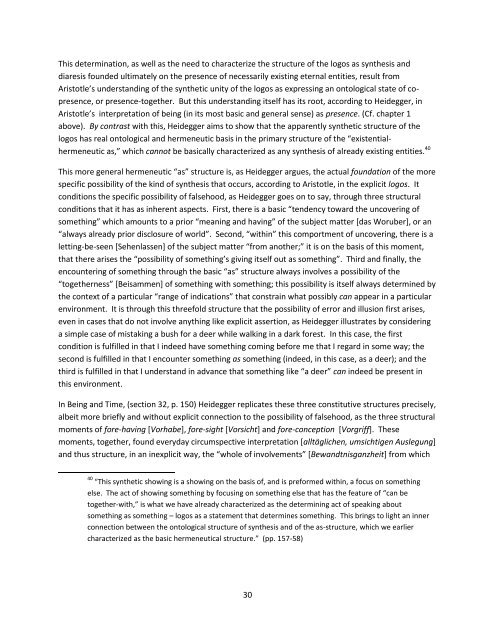Heidegger, Tugendhat, Davidson - University of New Mexico
Heidegger, Tugendhat, Davidson - University of New Mexico
Heidegger, Tugendhat, Davidson - University of New Mexico
Create successful ePaper yourself
Turn your PDF publications into a flip-book with our unique Google optimized e-Paper software.
This determination, as well as the need to characterize the structure <strong>of</strong> the logos as synthesis and<br />
diaresis founded ultimately on the presence <strong>of</strong> necessarily existing eternal entities, result from<br />
Aristotle’s understanding <strong>of</strong> the synthetic unity <strong>of</strong> the logos as expressing an ontological state <strong>of</strong> copresence,<br />
or presence-together. But this understanding itself has its root, according to <strong>Heidegger</strong>, in<br />
Aristotle’s interpretation <strong>of</strong> being (in its most basic and general sense) as presence. (Cf. chapter 1<br />
above). By contrast with this, <strong>Heidegger</strong> aims to show that the apparently synthetic structure <strong>of</strong> the<br />
logos has real ontological and hermeneutic basis in the primary structure <strong>of</strong> the “existentialhermeneutic<br />
as,” which cannot be basically characterized as any synthesis <strong>of</strong> already existing entities. 40<br />
This more general hermeneutic “as” structure is, as <strong>Heidegger</strong> argues, the actual foundation <strong>of</strong> the more<br />
specific possibility <strong>of</strong> the kind <strong>of</strong> synthesis that occurs, according to Aristotle, in the explicit logos. It<br />
conditions the specific possibility <strong>of</strong> falsehood, as <strong>Heidegger</strong> goes on to say, through three structural<br />
conditions that it has as inherent aspects. First, there is a basic “tendency toward the uncovering <strong>of</strong><br />
something” which amounts to a prior “meaning and having” <strong>of</strong> the subject matter [das Woruber], or an<br />
“always already prior disclosure <strong>of</strong> world”. Second, “within” this comportment <strong>of</strong> uncovering, there is a<br />
letting-be-seen [Sehenlassen] <strong>of</strong> the subject matter “from another;” it is on the basis <strong>of</strong> this moment,<br />
that there arises the “possibility <strong>of</strong> something’s giving itself out as something”. Third and finally, the<br />
encountering <strong>of</strong> something through the basic “as” structure always involves a possibility <strong>of</strong> the<br />
“togetherness” [Beisammen] <strong>of</strong> something with something; this possibility is itself always determined by<br />
the context <strong>of</strong> a particular “range <strong>of</strong> indications” that constrain what possibly can appear in a particular<br />
environment. It is through this threefold structure that the possibility <strong>of</strong> error and illusion first arises,<br />
even in cases that do not involve anything like explicit assertion, as <strong>Heidegger</strong> illustrates by considering<br />
a simple case <strong>of</strong> mistaking a bush for a deer while walking in a dark forest. In this case, the first<br />
condition is fulfilled in that I indeed have something coming before me that I regard in some way; the<br />
second is fulfilled in that I encounter something as something (indeed, in this case, as a deer); and the<br />
third is fulfilled in that I understand in advance that something like “a deer” can indeed be present in<br />
this environment.<br />
In Being and Time, (section 32, p. 150) <strong>Heidegger</strong> replicates these three constitutive structures precisely,<br />
albeit more briefly and without explicit connection to the possibility <strong>of</strong> falsehood, as the three structural<br />
moments <strong>of</strong> fore-having [Vorhabe], fore-sight [Vorsicht] and fore-conception [Vorgriff]. These<br />
moments, together, found everyday circumspective interpretation [alltäglichen, umsichtigen Auslegung]<br />
and thus structure, in an inexplicit way, the “whole <strong>of</strong> involvements” [Bewandtnisganzheit] from which<br />
40 “This synthetic showing is a showing on the basis <strong>of</strong>, and is preformed within, a focus on something<br />
else. The act <strong>of</strong> showing something by focusing on something else that has the feature <strong>of</strong> “can be<br />
together-with,” is what we have already characterized as the determining act <strong>of</strong> speaking about<br />
something as something – logos as a statement that determines something. This brings to light an inner<br />
connection between the ontological structure <strong>of</strong> synthesis and <strong>of</strong> the as-structure, which we earlier<br />
characterized as the basic hermeneutical structure.” (pp. 157-58)<br />
30
















